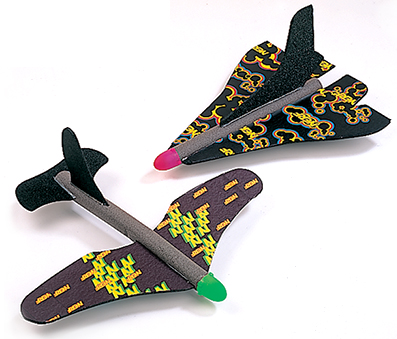Toy Gliders
Toymakers at Hasbro, Inc. of Pawtucket, Rhode Island are delighted with the "ups and downs" of a product that benefited from NASA expertise. Toy designers at the firm set their sights on creating a foam glider, one that a child could fly with little knowledge of aeronautics.
But early in its development, the Aero Nerf® gliders had one critical problem: they didn't fly so well! For toy gliders, that can surely dampen commercial sales.
Through the expertise of Don Steinman of NASA's Northeast Regional Technology Transfer Center, members of a Hasbro team were linked with aeronautical experts at Langley Research Center in Virginia. As glider hobbyists them selves, the NASA engineers provided essential information about how wing design and shape are integral to a glider's performance.
At issue was improving the overall flying distances and the loop-to-loop stunt qualities of Hasbro's prototype gliders. Langley's Gaudy Bezos-O'Connor, an experimental aerodynamicist by training and a technology transfer specialist, took on the challenge. So too did Ray Whipple, a wind tunnel manager at Langley and specialist in testing model airplanes. Two retirees from Langley, Dave Robelin and Hewitt Phillips, also brought their aeronautical know -how to the project, rounding out the NASA team.
The benefit of the NASA and Hasbro partnership was indeed an uplifting experience, in more ways than one. The toy company is intent on becoming an aggressive force in the toy glider market, part of the highly competitive, multi -billion dollar toy industry. As a step toward that objective, Hasbro's senior design director, Todd W. Wise, perhaps put it best, "Who knows better how to make things fly than NASA."
Elegant but simple was the rule of the day. The gliders had to fly and perform on the basis of their shape, without benefit of changes in any control surface. Propulsion for the glider had to come from a toss of the hand, without the aid of a sling shot or other device.
The Hasbro designers received from NASA not only technical guidance but a hands-on tutorial on the physics of designing and flying gliders. Where to place the wings on a glider's fuselage and the correct angle for its tail surfaces proved critical in the foam toy's make-over. With a better understanding of flight and how to shape the foam, Hasbro designers went back to their drawing boards. The final products, quite literally, "soared" beyond the design team's expectations.
The result? Several versions of a Nerf glider were realized from the collaboration. For instance, the Super Soaring Glider™ can make long-range, high-performance flights. The Ultra Stunt Glider™ is ideal for performing aerial acrobatics. It can execute thrilling loops and turns, all from a simple throw.
NASA has long shared its imaginative approaches in designing aircraft, teaming with aviation and aerospace companies. The Aero Nerf gliders meant leveraging decades of aeronautical skill honed at Langley in scale-model, low -speed, aircraft design research and wind tunnel testing.
A real toy story come true!
Aero Nerf is a registered trademark of Hasbro, Inc.
Super Soaring Glider and Ultra Stunt Glider are trademarks of Hasbro, Inc.

Winging their way into toy stores are Hasbro Aero Nerf Gliders, benefiting from NASA wind tunnel and aerodynamic expertise.













